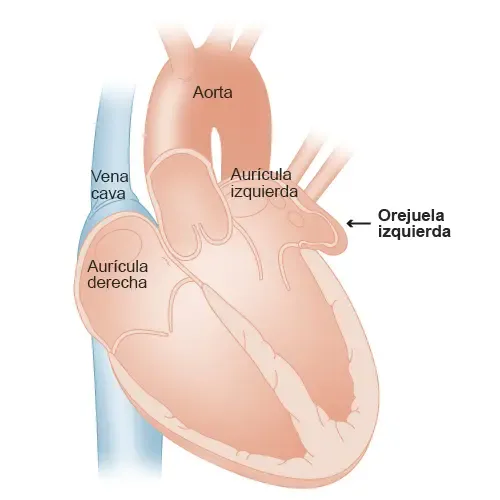Left atrial appendage closure
"The closure of the appendage is a clear example of the need to bet on personalized medicine to find the best treatment for each patient."
DR. RAFAEL RUIZ SALMERÓN SPECIALIST. HAEMODYNAMIC AND INTERVENTIONAL CARDIOLOGY UNIT

What is atrial appendage closure?
Left atrial appendage closure is a procedure that has gained relevance in recent years. This treatment aims to prevent patients with atrial fibrillation from having to take anticoagulants for the rest of their lives.
Atrial fibrillation is the most common arrhythmia (heart rhythm disturbance). With this type of arrhythmia, the blood remains stagnant in the left atrial appendage, which favors the formation of embolisms that can detach to other blood vessels, such as those in the brain, reducing blood flow and causing a stroke. Specifically, this episode multiplies the risk of stroke fivefold, so treatment with anticoagulants is necessary to prevent blood clotting and avoid the formation of thrombi and embolisms.
Taking anticoagulants increases the risk of bleeding because some of them, such as Sintrom® , require constant monitoring and it can be difficult to control the optimal dose because they frequently interact with food, other drugs or other diseases that the patient may have.

Left atrial appendage related problems
To understand the procedure for atrial appendage closure of the heart, it is first necessary to understand what the atrial appendage is and what its function is. The atrial appendage is a small cavity located at the top of the left atrium of the heart. Its function is to act as a kind of reservoir for blood flowing into the atria.
When the heart does not beat efficiently, blood may stagnate in the left atrium. This situation favors the formation of blood clots, which can break off and travel to other parts of the body, such as the brain, causing a cerebrovascular accident (CVA) or embolism.
One of the most common causes of this problem is atrial fibrillation (AF), a cardiac arrhythmia that causes irregular contractions of the atria, affecting millions of people worldwide.
Are you taking anticoagulants for your atrial fibrillation?
By closing the left ear flap, you can stop taking them.
Percutaneous atrial appendage closure procedure
Atrial appendage closure of the heart is performed by a minimally invasive procedure known as percutaneous closure.
How the lug fastener is made
Before performing an atrial appendage closure, the physician will perform a series of tests to determine whether the patient is suitable for this treatment. These tests include transesophageal echocardiography and computed tomography to analyze the anatomy of the atrial appendage and to rule out the presence of clots prior to the procedure.
On the day of the procedure:
- The patient is administered anesthesia and a puncture is made in the groin to access the venous system.
- Through a catheter, a closure device (such as the Watchman) is inserted into the left atrial appendage.
- The device is deployed inside the appendage, sealing it and preventing the passage of clots into the bloodstream.
- Finally, the catheter is removed and the groin puncture is closed.
This procedure usually lasts between one and two hours, and the patient is usually discharged the following day.
- Percutaneous appendage closure is considered safe and effective in the prevention of stroke in appropriately selected patients.
Complications of atrial appendage closure of the heart
Although atrial appendage closure of the heart is a safe procedure, like any medical intervention, it can present some complications.
These may include bleeding at the puncture site, infection, damage to cardiac or vascular structures, and device thrombosis.
However, these adverse events are infrequent and, in general, the safety profile of atrial appendage closure is favorable.
Anticoagulation after atrial appendage closure
Anticoagulation therapy after atrial appendage closure varies according to the patient and the device used.
In general, short-term anticoagulation or antiplatelet therapy is administered to prevent clot formation in the device. The medication is then adjusted according to the patient's progress and the anticoagulation therapy is discontinued.
Postoperative follow-up of left atrial appendage closure
Follow-up after atrial appendage closure is critical to ensure the success of the treatment. The physician will perform periodic imaging tests, such as transesophageal echocardiography, to evaluate the position of the device, the absence of clots and the adequate sealing of the atrial appendage.
Clinical monitoring is also important to assess tolerance to the medication and to detect possible complications in time.
Where do we do it?
IN NAVARRA AND MADRID
The Department of Cardiology
of the Clínica Universidad de Navarra
The Department of Cardiology of the Clinica Universidad de Navarra is a center of reference in different diagnostic techniques and coronary treatments.
We have been the first center in Europe to place a pacemaker by means of a catheterization without the need to open the chest, for cases of severe heart failure.
The Cardiology Department of the Clinic collaborates with the Radiology and Cardiac Surgery Departments to achieve a quick and precise diagnosis of the patient.

Why at the Clinica?
- Specialized Arrhythmia Unit of national reference.
- Unit of Hemodynamics and Interventionist Cardiology equipped with the best technology.
- Cardiac Imaging Unit to achieve the highest diagnostic accuracy.




















